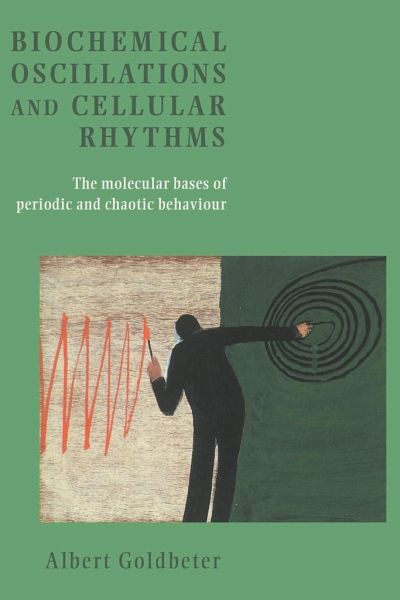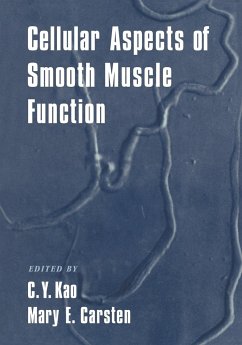
Biochemical Oscillations and Cellular Rhythms
Versandkostenfrei!
Versandfertig in 1-2 Wochen
111,99 €
inkl. MwSt.

PAYBACK Punkte
56 °P sammeln!
This book addresses the molecular bases of some of the most important biochemical rhythms known at the cellular level. Clarifying the mechanism of these oscillatory phenomena is of key importance for understanding the origin as well as the physiological function of these rhythms, and the conditions in which simple periodic behaviour transforms into complex oscillations including bursting and chaos. It will appeal to graduate students and researchers in a wide variety of fields. On the one hand, it will be of interest to life scientists such as biochemists, cell biologists, medical scientists, ...
This book addresses the molecular bases of some of the most important biochemical rhythms known at the cellular level. Clarifying the mechanism of these oscillatory phenomena is of key importance for understanding the origin as well as the physiological function of these rhythms, and the conditions in which simple periodic behaviour transforms into complex oscillations including bursting and chaos. It will appeal to graduate students and researchers in a wide variety of fields. On the one hand, it will be of interest to life scientists such as biochemists, cell biologists, medical scientists, pharmacologists and chronobiologists. On the other hand, scientists studying nonlinear phenomena, including oscillations and chaos, in chemistry, physics, mathematics and mathematical biology will also find these ideas of value.
Table of contents:
1. Introduction; Part I. Glycolytic Oscillations: 2. Oscillatory enzymes: simple periodic behaviour in an allosteric model for glycolytic oscillations; Part II. From Simple to Complex Oscillatory Behaviour; 3. Birhythmicity: coexistence between two stable rhythms; 4. From simple periodic behaviour to complex oscillations, including bursting and chaos; Part III. Oscillations Of Cyclic Amo In Dictyostelium Cells: 5. Models for the periodic synthesis and relay of camp signals in Dictyostelium discoideum amoebae; 6. Complex oscillations and chaos in the camp signalling system of Dictyostelium; 7. The onset of camp oscillations in Dictyostelium as a model for the ontogenesis of biological rhythms; Part IV. Pulsatile Signalling In Intercellular Communication: 8. Function of the rhythm of intercellular communication in Dictyostelium. Link with pulsatile hormone secretion; Part V. Calcium Oscillations: 9. Oscillations and waves of intracellular calcium; Part VI. The Mitotic Oscillator: 10. Modelling the mitotic oscillator driving the cell division cycle; Part VII. Circadian Rhythms: 11. Towards a model for circadian oscillations in the Drosophila period protein (PER); 12. Conclusions and perspectives; References.
This book addresses the molecular bases of some of the most important biochemical rhythms known at the cellular level. Clarifying the mechanism of these oscillatory phenomena is of key importance for understanding the origin as well as the physiological function of these rhythms.
First time paperback of a successful chaos/biochemistry monograph.
Table of contents:
1. Introduction; Part I. Glycolytic Oscillations: 2. Oscillatory enzymes: simple periodic behaviour in an allosteric model for glycolytic oscillations; Part II. From Simple to Complex Oscillatory Behaviour; 3. Birhythmicity: coexistence between two stable rhythms; 4. From simple periodic behaviour to complex oscillations, including bursting and chaos; Part III. Oscillations Of Cyclic Amo In Dictyostelium Cells: 5. Models for the periodic synthesis and relay of camp signals in Dictyostelium discoideum amoebae; 6. Complex oscillations and chaos in the camp signalling system of Dictyostelium; 7. The onset of camp oscillations in Dictyostelium as a model for the ontogenesis of biological rhythms; Part IV. Pulsatile Signalling In Intercellular Communication: 8. Function of the rhythm of intercellular communication in Dictyostelium. Link with pulsatile hormone secretion; Part V. Calcium Oscillations: 9. Oscillations and waves of intracellular calcium; Part VI. The Mitotic Oscillator: 10. Modelling the mitotic oscillator driving the cell division cycle; Part VII. Circadian Rhythms: 11. Towards a model for circadian oscillations in the Drosophila period protein (PER); 12. Conclusions and perspectives; References.
This book addresses the molecular bases of some of the most important biochemical rhythms known at the cellular level. Clarifying the mechanism of these oscillatory phenomena is of key importance for understanding the origin as well as the physiological function of these rhythms.
First time paperback of a successful chaos/biochemistry monograph.














